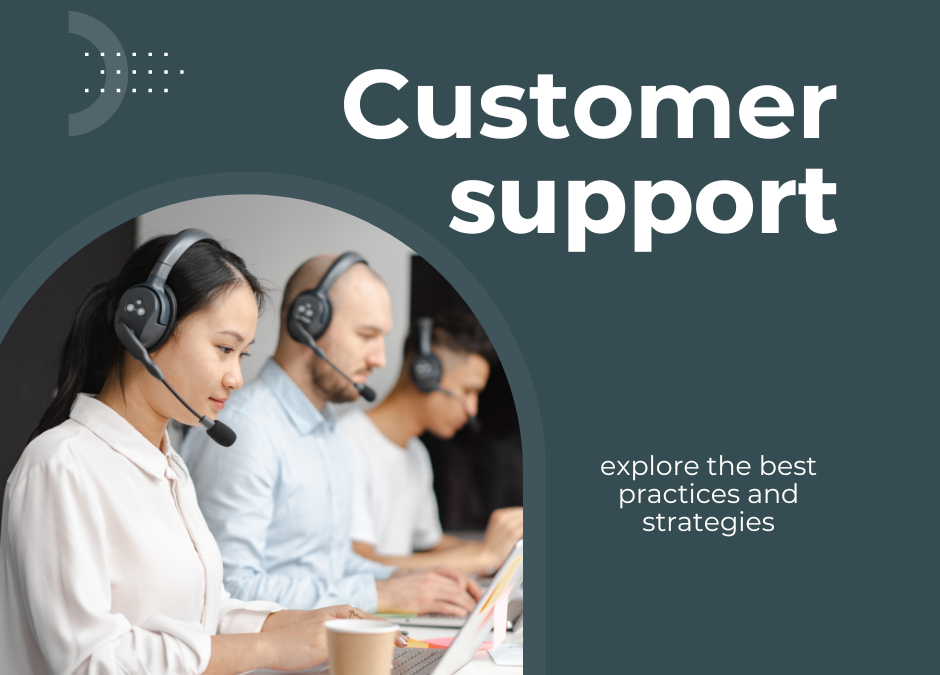


How to Become a Customer Service Representative Without Experience
This comprehensive guide teaches you how to become a customer service representative without experience. It also provides essential skills, step-by-step strategies, and valuable resources to help you enter the field and succeed in your job search. Whether you’re a recent graduate or looking to transition careers, this article provides practical tips and insights to help you land your dream role in customer service. Start your journey today!
Understanding the Role of a Customer Service Representative
Before discussing how to become a customer service representative, it’s crucial to understand the role and responsibilities associated with this position. Customer service representatives are a company’s frontline, serving as the primary point of contact between the business and its customers. Their main objectives are to assist, address inquiries, resolve issues, and ensure customer satisfaction.
Essential Skills Required for Success
While prior experience is valuable, it’s not the only factor determining customer service success. Employers often look for candidates with a combination of essential skills and qualities, including:
- Excellent communication skills
- Empathy and patience
- Problem-solving abilities
- Adaptability and flexibility
- Strong interpersonal skills
- Attention to detail
Steps to Become a Customer Service Representative Without Experience
- Research the Industry and Companies
Start by researching the customer service industry and familiarizing yourself with various customer service roles available. Look into different companies and industries that interest you, paying attention to their customer service practices, values, and job requirements.
- Develop Relevant Skills
While you may not have direct experience in customer service, you likely possess transferable skills that apply to the role. Focus on honing skills such as communication, problem-solving, and empathy through relevant experiences, such as volunteer work, internships, or part-time jobs.
- Customize Your Resume and Cover Letter
Craft a tailored resume and cover letter highlighting your relevant skills, experiences, and achievements. Emphasize any customer-facing roles or responsibilities you’ve had in the past, even if they were not formally in a customer service capacity.
- Leverage Networking Opportunities
Networking can be a powerful tool in your job search, especially when trying to break into a new field. Attend industry events, connect with professionals on LinkedIn, and contact contacts within your network for informational interviews or job referrals.
- Ace the Interview
Prepare thoroughly for customer service job interviews by researching the company, practicing common interview questions, and showcasing your enthusiasm for the role. Be prepared to provide examples of how you’ve demonstrated essential skills in past experiences, even if they were outside of traditional customer service settings.
- Showcase Your Potential
During the interview process, emphasize your willingness to learn, adapt, and grow within the role. Highlight any relevant training programs, certifications, or online courses you’ve completed to demonstrate your commitment to professional development.
- Demonstrate Customer-Centricity
Emphasize your dedication to providing exceptional customer experiences and resolving issues efficiently. Share stories or examples that illustrate your ability to empathize with customers, anticipate their needs, and go above and beyond to exceed expectations.
Additional Resources
For further guidance on how to become a customer service representative without experience, consider exploring the following resources:
Conclusion: Steps to Become a Customer Service Representative Without Experience
While breaking into the customer service field without prior experience may present challenges, it’s feasible with the right approach and mindset. By developing relevant skills, customizing your application materials, leveraging networking opportunities, and showcasing your potential during interviews, you can position yourself as a strong candidate for customer service roles. Remember to stay proactive, persistent, and positive throughout your job search.

The Truth about Revenue Definition Explained in Simple Terms
Revenue Definition:
Hey there, curious minds!
Ever found yourself scratching your head when the term "revenue" comes up in business discussions?
Fret not; you're not alone.
In this article, we'll embark on a journey to demystify revenue.
Also break down the formula, delve into calculations, and sprinkle in some real-world examples to make things crystal clear.
What is the Definition of Revenue?
Let's kick things off with the basics.
Of course, Revenue is the lifeblood of any business—it's the money flowing in from all those products or services you're offering.
So, think of it as the paycheck your business receives for a job well done.
Revenue Definition and the Formula Unveiled
Now, let's get down to the nitty-gritty.
First of all, the formula for revenue is as straightforward as it gets:
Revenue=Number of Units Sold×Price per UnitRevenue=Number of Units Sold×Price per Unit
For the most part simple, right?
No matter what you're selling. If it is widgets, gadgets, or doodads.
Certainly, this formula holds the key to unlocking your business's financial potential.
Revenue Definition and Crunching the Numbers
Let's break down the components of the formula.
And see how they dance together.
Imagine you're running a cozy online bookstore.
You sell 100 books (that's your number of units sold) at $20 each (the price per unit).
So, plug these numbers into the formula, and voila:
Revenue=100×$20=$2000Revenue=100×$20=$2000
As a result, there you have it—$2000 in revenue! It's like solving a puzzle, isn't it?
Exploring Collections: Diving into Different Revenue Streams
Now, let's spice things up a bit by exploring different revenue streams, shall we?
Collections on our website can be likened to the diverse offerings in a business.
From e-books to audiobooks, each collection represents a unique avenue for revenue.
- E-books Collection
- Offering a digital haven for bookworms, our e-books collection caters to the tech-savvy reader. Dive into this collection to understand how digital sales contribute to your overall revenue pie.
- Audiobooks Collection
- For those who prefer a narrative on the go, audiobooks are the way to go. Explore how this collection adds a melodious note to your revenue stream.
Real-world Examples for Revenue Definition: Bringing Theory to Life
Again, theory is all well and good, but let's ground our understanding with some real-world examples.
"Our E-books Collection saw a 30% boost in revenue last quarter, thanks to a strategic partnership with popular authors."
In fact, here, a tangible example highlights the impact of business decisions on revenue growth.
Why Revenue Matters
Now that we've grasped the nuts and bolts, let's explore why revenue is the linchpin of business success.
- Business Growth
- Revenue is the fuel that propels your business forward. It's not just about making money; it's about funding expansion, innovation, and staying ahead of the competition.
- Investor Attraction
- Investors are like bees to honey. A healthy revenue stream attracts potential investors, indicating a thriving and profitable venture.
"Our consistent revenue growth caught the eye of investors, leading to a fruitful collaboration that propelled us to new heights."
Conclusion: Navigating the Revenue Definition Landscape
In conclusion, understanding revenue is like navigating a bustling city.
Therefore, you need a map and a sense of direction.
Because collections serve as landmarks.
As a result, guiding you through the diverse terrain of revenue streams.
While real-world examples act as signposts, showing you the way forward.
So, next time someone throws around terms like "revenue," or “revenue definition,” you can nod knowingly.
Above all, armed with the knowledge of formulas, calculations, and real-world anecdotes.
Happy navigating and may your revenue sail smoothly into the sunset of success!

The Ultimate Ecommerce SEO You Need To Know For Online Success
Are you interested in starting an online store or have an existing one? Then you need to know about eCommerce SEO!
First of all, let's break down what eCommerce SEO means. "Ecommerce" means buying and selling things online. While "SEO" stands for Search Engine Optimization.
Basically, eCommerce SEO means optimizing your online store. As a result, appears higher in search engine results. Especially, when people search for products you sell.
Why is eCommerce SEO important?
Because, when people search for something online, they usually only look at the first few results.
In that case, your store isn't showing up on the first page of search results.
And it is unlikely that people will find it.
For this reason, optimize your store for search engines. Henceforth, you can attract more visitors and potential customers.
In this article, we will cover the ultimate ecommerce SEO strategies you need to know for online success.
Research your Keywords for eCommerce SEO
Indeed, optimize your store for search engines. Because, you need to know what keywords people are using to search for products like yours. Therefore, use keyword research tools like Google Keyword Planner to find the best keywords for your store.
Optimize your product pages:
Make sure each of your product pages has a unique and descriptive title.
As well as a detailed product description. Likewise, use your chosen keywords in these areas. But don't overdo it.
Then make certain your content reads naturally and provides value to the reader.
Of course, don't forget to send your web page or blog your subscribers.
Why Improving your website's loading speed is an Important part of eCommerce SEO
As a matter of fact, slow-loading websites can negatively affect your search engine rankings. Again, use tools like Google's Page Speed Insights to find areas for improvement.
Get Quality Backlinks for Your eCommerce Website
Given these points, backlinks are links to your website from other websites. Because, the higher quality websites that link to your store, the higher your search engine rankings can be. Of course, you may want to reach out to other websites in your industry. And offer to write guest blog posts or collaborate on content.
Use social media for your eCommerce Search Engine Ranking
Social media can be a great way to drive traffic to your store.
In addition, improve your search engine rankings. For this reason, share your products and content on your social media profiles.
And encourage your followers to share them as well.
In Summary of eCommerce SEO
In summation, commerce SEO is necessary for online success.
You can increase your ecommerce site's search engine visibility.
And draw in more prospective customers.
As a matter of fact, use these tactics described in this article. However, keep in mind to prioritize local SEO and technical SEO.
Also, content marketing, link development, and keyword study.
Given these points, you can outrank your rivals and succeed online with enough time and work.

How To Use Persona-based Marketing To Drive Sales
Persona-based Marketing:
As a marketer, you are always looking for ways to increase your revenue and grow your business.
One way to achieve this is through persona-based marketing.
Persona-based marketing is a strategy.
Involves creating detailed profiles of your target audience.
Or personas, to better understand their needs and preferences.
So, use these personas to guide your marketing efforts.
Because you can create more personalized and effective campaigns.
In fact, will help you reach your goals.
In this article, we will discuss how you can maximize your affiliate program's potential with persona-based marketing.
The Importance of Persona-based Marketing Understand Your Target Audience
The first step in creating effective personas is to understand your target audience.
Because, you need to know who they are, what their needs and preferences are, and what motivates them to make a purchase.
To do this, you can use a variety of tools, such as surveys, customer feedback, and market research.
Develop a Detailed Persona-based Marketing Info
First of all, have a clear understanding of your target audience.
So, you can begin developing detailed personas.
Again, these personas should include certain information.
Such as age, gender, income, education level, occupation, and interests.
Equally important, you should also include information about their buying habits.
Especially, preferred channels for communication, and pain points.
Create Personalized Content
Once you have developed your personas, you can use them to guide your content creation efforts.
In other words, create content that is tailored to the specific needs and preferences of your target audience.
As a result, you can increase engagement and drive conversions.
Use Targeted Advertising for Persona-based Marketing
Another way to use personas in your affiliate marketing efforts is through targeted advertising.
So, use the information you have gathered about your personas.
Therefore, you can create highly targeted ads.
That are more likely to resonate with your target audience.
Measure Your Results for Persona-based Marketing
Finally, it is important to measure the results of your persona-based marketing efforts.
Because this will help you to decide what is working and what is not.
For this reason, you can adjust as needed.
Also, use a variety of tools to measure your results.
Such as Google Analytics, social media analytics, and email marketing metrics.
In Conclusion of Persona-based Marketing
In conclusion, persona-based marketing is a powerful tool.
That can help you to maximize your affiliate program's potential.
Certainly, by understanding your target audience.
So, develop detailed personas and create personalized content.
In that case, use targeted advertising, and measure your results.
After all, you can create more effective and engaging campaigns.
Of course, will drive conversions and increase your revenue.
If you want to read more information about how to boost your website traffic just visit --> "https://seowebtoolsmagic.com"

What Are The Most Profitable Online Businesses 2023
What are the most profitable online businesses:
There are various most profitable online businesses in the US.
However, these depend on factors such as market demand, competition, and execution.
Here are a few examples:
E-commerce: Running an online store that sells products directly to consumers can be highly profitable.
The e-commerce industry has been growing rapidly in recent years.
and consumers are increasingly turning to online shopping for convenience and lower prices.
Therefore, successful e-commerce businesses can sell anything from physical products to digital goods and services.
Problem
One common problem in ecommerce is that customers abandon their carts before completing the checkout process.
This can be frustrating for both the customer and the ecommerce business, as it can result in lost sales and revenue.
Solution
One effective solution to this problem is to implement an abandoned cart email campaign.
This involves sending automated emails to customers who have added items to their cart but haven't completed the checkout process.
These emails can include a reminder of the items in their cart, as well as incentives such as discounts or free shipping to encourage them to complete their purchase.
In addition to abandoned cart emails, ecommerce businesses can also implement other strategies to reduce cart abandonment.
Such as simplifying the checkout process, offering multiple payment options, and providing clear and transparent pricing and shipping information.
By addressing the reasons why customers may be abandoning their carts, ecommerce businesses can improve their conversion rates and increase their overall revenue.
Why Affiliate marketing is one of the most profitable online businesses?
Affiliate marketing: This involves promoting other people's products and earning a commission for each sale made through your referral link.
For example, affiliate marketing, like the healthcare or weightloss niche can be highly profitable.
Especially, if you have a large and engaged audience, as well as good marketing skills.
Problem
One common problem in affiliate marketing is low conversion rates.
Even if an affiliate marketer has a good website, great content, and drives traffic to their site, it doesn't guarantee that visitors will convert into customers.
Solution
One solution to this problem is to optimize the affiliate marketing strategy to improve conversion rates. This can be done by focusing on the following:
Targeting the right audience: It's essential to target the right audience that's interested in the product or service being promoted. It's important to understand the audience's needs, interests, and pain points to create content that resonates with them.
Creating high-quality content: High-quality content that provides value to the audience is crucial to increasing conversion rates. The content should be informative, engaging, and visually appealing.
Building trust: Building trust with the audience is key to increasing conversions. This can be done by promoting only high-quality products or services that are relevant to the audience and by providing honest and unbiased reviews.
Optimizing the user experience: The user experience on the affiliate marketer's website should be optimized to make it easy for visitors to find what they're looking for and to complete the purchase process. This includes having clear calls-to-action, easy navigation, and a fast-loading website.
By focusing on these areas, an affiliate marketer can improve their conversion rates and increase their earnings.
Online Courses: most profitable online businesses
Online learning has become increasingly popular in recent years due to its convenience and flexibility.
However, it also comes with its own set of challenges.
In this article, we’ll explore some of the common problems that students may face when taking online courses.
And provide solutions to help overcome them.
Problem 1: Technical difficulties
One of the most common problems that students face when taking online courses is technical difficulties.
These can range from poor internet connectivity to malfunctioning hardware or software.
Also, can cause frustration and delays in completing coursework.
Solution
Encourage students to troubleshoot their technical issues first by checking their internet connection.
As well as restarting their device or updating their software.
Provide a tech support team or a FAQ page to help students resolve common issues.
It is also a good idea to provide a backup plan in case of an extended outage.
Such as allowing students to submit work via email or extending deadlines.
Problem 2: Lack of interaction and engagement
Online courses can be isolating for some students.
For that reason, they may miss social interactions.
And engagement that comes with traditional classroom learning.
This can lead to feelings of disconnection and disengagement from the course material.
Solution
Incorporate interactive elements such as discussion forums.
Above all group projects, and live video conferencing sessions.
In that case, encourage engagement and foster a sense of community among students.
Assign group work that requires collaboration and communication to help students build relationships with their peers.
Encourage instructors to supply personalized feedback.
Of course, support helps students stay motivated.
Drop Shipping: one of the most profitable online Businesses
Drop shipping is a popular business model.
Furthermore, allows online retailers to sell products without holding inventory.
Instead, the retailer transfers the order and shipment details to a supplier.
Who then fulfills the order on behalf of the retailer.
Hence, this business model has several benefits, such as lower startup costs and reduced risks.
It also has some challenges that retailers need to be aware of.
The Problem
One common problem with drop shipping is that retailers have little control over the product quality and shipping process.
This can result in delayed or incorrect shipments, damaged products, or poor customer service.
The Solution
Product selection: To avoid competing with other sellers offering the same products, retailers should choose unique and niche products that appeal to a specific target audience. They should also conduct market research to find trending products and adapt their product offerings accordingly.
Supplier management: Retailers should set up a good relationship with their suppliers by communicating regularly and providing feedback on product quality and shipping times. They should also negotiate favorable terms, such as lower prices, faster shipping, and exclusive product lines.
Brand building: To stand out in a crowded market, retailers should focus on building a strong brand that reflects their values, personality, and mission. They should create a memorable brand name, logo, and website design, and use social media and other marketing channels to connect with their audience.
Customer service: Retailers should supply exceptional customer service by offering fast and helpful responses to inquiries and complaints, providing tracking information, and offering refunds and returns when necessary. They should also use customer feedback to improve their products and services.
Legal and financial compliance: Retailers should consult with legal and financial experts to ensure compliance with relevant laws and regulations, such as tax laws, intellectual property rights, and consumer protection laws. They should also choose secure payment processors and maintain accurate financial records.
By implementing these solutions, drop shipping retailers can overcome the common problems associated with this business model and build a successful and profitable online business.
Software as a service (SaaS): most profitable online businesses
Software refers to the programs and applications that run on computers, smartphones, and other digital devices.
Seems like, software has revolutionized the way we work and communicate.
And entertain us, it can also be a source of frustration when things go wrong.
In conclusion, software is an essential part of our daily lives.
But it can also be a source of frustration when things go wrong.
Of course, by understanding common problems and solutions, we can better navigate the world of software and enjoy its benefits while minimizing its risks.
The Problem
One common problem with software is bugs. Bugs are errors or defects in the code that cause the software to behave in unexpected ways.
Another problem with software is compatibility issues.
Also, Security is a major concern when it comes to software. Hackers and other malicious actors can exploit vulnerabilities in software.
The Solution
To prevent bugs in software, software developers should prioritize testing and quality assurance processes during the development stage.
This includes finding potential issues early in the development cycle.
And conducting thorough testing to ensure the software works as intended.
In that case, users can also help by providing feedback and reporting bugs to the software company or developer.
To solve compatibility issues, software developers must ensure that their software is compatible.
Especially with multiple operating systems. Also, hardware configurations, and other software applications.
They can also supply updates or patches to address compatibility issues as they arise.
So, users can check system requirements before purchasing or downloading software.
And make sure their devices meet those requirements.
To address security concerns, software developers should implement security measures.
Such as encryption, firewalls, and regular software updates.
This includes identifying and patching vulnerabilities as they are discovered.
Users should also take steps to protect their devices. Such as using strong passwords and avoiding downloading software from untrusted sources.
Certainly, regularly updating their software and operating systems.
Overall, software developers and users should work together to ensure that software is reliable, compatible, and secure.
In that case, prioritizing quality, compatibility, and security.
So we can continue to benefit from the many ways in which software enriches our lives.





















